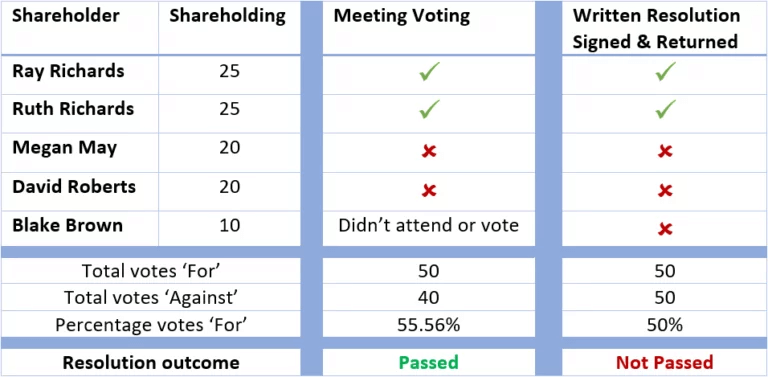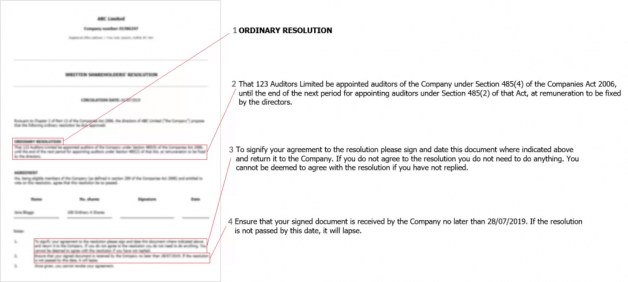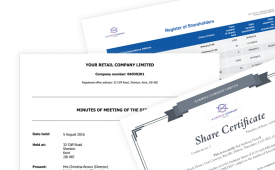Written resolutions are an important instrument in a company’s toolkit for agreeing both directors’ and shareholders’ resolutions without needing to hold a meeting. Here we’ll discuss:
Shareholders’ written resolutions have many rules for their proposal, contents and circulation, which we’ll explore in detail. The contents and use of directors’ written resolutions are covered more by the company’s articles than the Companies Act – these are covered specifically at the end of this article.
Need written resolution templates?
Inform Direct has over 300 templates available, including written directors' and shareholders' resolutions.
Note: Throughout this article, reference is made to a company’s members as ‘shareholders’ as this is the most familiar type of member, but this information applies equally to members in a company limited by guarantee.
What is a written resolution?
A written resolution is a document that describes a company decision (as a resolution) that can be circulated to the required audience (shareholders/directors), with them able to sign and return it – confirming their agreement.
An example of a shareholders’ written resolution, and what it must contain, is included later in this article.
Written resolutions can be used:
- Instead of a holding a general meeting for:
- Shareholder ordinary resolutions
- Shareholder special resolutions
- Instead of holding a board meeting for:
- Directors’ resolutions
Why might a company choose to use a written resolution?
Companies may make some, all or none of their decisions by written resolution. Most companies will use them when appropriate because they can:
- Be easier – if the directors/shareholders are not close geographically
- Make it faster – as it can remove the administration of calling and running a shareholder/board meeting (for what may be a single decision)
- Be a better option for a specific decision – if there is no upcoming or regular board/shareholder meeting and you need a specific decision to be made quickly
- Just make more sense:
- If a company has just one director/shareholder – it would be strange for them to hold a meeting on their own
- Calling a meeting that can effectively be made by a single majority shareholder would be wasting everyone’s time.
Shareholder written resolutions
The requirements for passing a written shareholders’ resolution are the same as those at a meeting:
- Ordinary resolution – more than 50% (a ‘simple majority’)
- Special resolution – 75% or more
While these percentage requirements are the same as those at a meeting, there is an often overlooked but key difference:
- Not attending a meeting (and not voting via proxy) counts as not voting, whereas
- Not responding to a written resolution counts as a vote ‘against’ the resolution
This can cause a different outcome for the resolution, as demonstrated in the following example.
Example
A company has five shareholders:
- Two holding 25 shares each – will vote ‘For’ the resolution
- Two holding 20 shares each – will vote ‘Against’ the resolution
- One holding 10 shares – usually doesn’t attend meetings or vote
Here are the voting outcomes of a meeting vs written resolution:

As shown here, a resolution passing can entirely hinge on the method used to propose it.
When can a written shareholders’ resolution be used?
Written shareholders’ resolutions can be used for all ordinary or special resolutions, except for:
- Removal of an auditor before their term of office expires
- Removal of a director before their period of office expires
Public limited companies cannot use written shareholders’ resolutions to make decisions unless it is specifically permitted in their articles of association.
How are they proposed?
Circulation of a written resolution can be requested by:
- The company’s officers – where it can then be circulated
- Shareholders of the company – where it must then follow the below rules to be circulated
The shareholder must send the request to the company by hard copy (paper) or electronically, and it must:
- Identify the resolution being requested for proposal
- Include any accompanying statement
- Be signed by those making the request
For a the proposal to be accepted for circulation it must pass certain criteria:
- At least 5% of the shareholders eligible to vote on the resolution have requested that it be circulated (or a lower percentage if specified in the company’s articles)
- If passed, it must be able to be effective (so it doesn’t cause an inconsistency with the company’s constitution)
- It must not be defamatory of any person
- It must not be frivolous or vexatious – so it must have value/purpose, and not just be to cause nuisance
The requesting shareholder(s) can write up to 1,000 words about the resolution being circulated, which then must be circulated with it.
What must be included in the written resolution?
The circulated written resolution document must include:
- Whether it is a special or ordinary resolution
- The wording of the resolution
- A description of how shareholders can signify agreement
- The date by which the resolution must be passed, else it will lapse (28 days from circulation date unless stated otherwise in the company’s articles)
It’s fine for a circulated written resolution document to contain multiple resolutions – including a mixture of ordinary and special resolutions.
How is the written resolution circulated?
All shareholders (entitled to vote on it) must be sent the written resolution. A copy must also be sent to the company’s auditors (where appointed).
A shareholder is eligible to vote if they were eligible to vote on the date of circulation (and time of circulation to the first shareholder if it comes down to it).
The resolution should be sent to all recipients at the same date and time (so far as reasonably practicable) by:
- Hard copy, or
- Electronically, or
- By means of a website
Or, so long as it doesn’t cause delay the same copy can be sent to each recipient in turn, or a combination of these two methods.
Failure to circulate the resolution correctly is an offence and can lead to a fine for the officers responsible.
Note: If the resolution was proposed by shareholders then any accompanying statement from them must be circulated with the written resolution (it is possible to get the accompanying statement suppressed by application to the court).
How is agreement signified by a shareholder?
Each shareholder will usually sign and return the written resolution to the company to signify agreement. This can be on paper or electronically.
However, the Companies Act deems a shareholder’s agreement as signified when an authentic document is received by the company that both:
- Identifies the resolution to which it relates; and,
- Indicates their agreement to the resolution
This allows for agreement to be signified by email response or performing an action on a website – so long as it is allowed by the company’s articles.
It is not possible to revoke your agreement once it is received by the company.
The written resolution can have one of two outcomes:
- Not passed – if by the expiry date the requisite percentage is not reached, then the resolution lapses
- Passed – once the requisite percentage is reached the resolution is deemed as passed
- The same Companies House filing and record keeping requirements for ordinary and special resolutions passed at a meeting are required
Filing written resolutions at Companies House
Some resolutions need to be filed with Companies House (mainly special resolutions). In another article we explain which these are. These need to be sent to Companies House whether they are agreed by a written resolution, or a resolution during a meeting.
Historically, these had to be sent in hard copy in the post to Companies House, but in response to the coronavirus pandemic in 2019 Companies House introduced the ability to upload these online. It would please many companies for this to be done through their company secretarial software (like Inform Direct) but unfortunately Companies House have not yet allowed this. Currently it can only be uploaded through their own website.
Directors’ written resolutions
Directors’ decisions can usually be made via written resolutions. The company’s articles document if they are permitted or not, and you’ll find that the model articles, and most other articles allow for them. Again, the company’s articles control this, but usually they can only be passed by unanimous agreement of all eligible directors.
A director is ‘eligible’ if there is no conflict of interest for them in voting. For example, the decision could be to award a contract to a company that one of the directors is involved in. That director would likely be ineligible to vote on this resolution.
Just like a shareholders’ written resolution, once documented this needs to be:
- Sent to each director on paper or electronically (if the company’s articles permit this)
- Signed by the eligible directors to signify agreement and returned
As with the minutes of a board meeting, this must be kept for 10 years.


